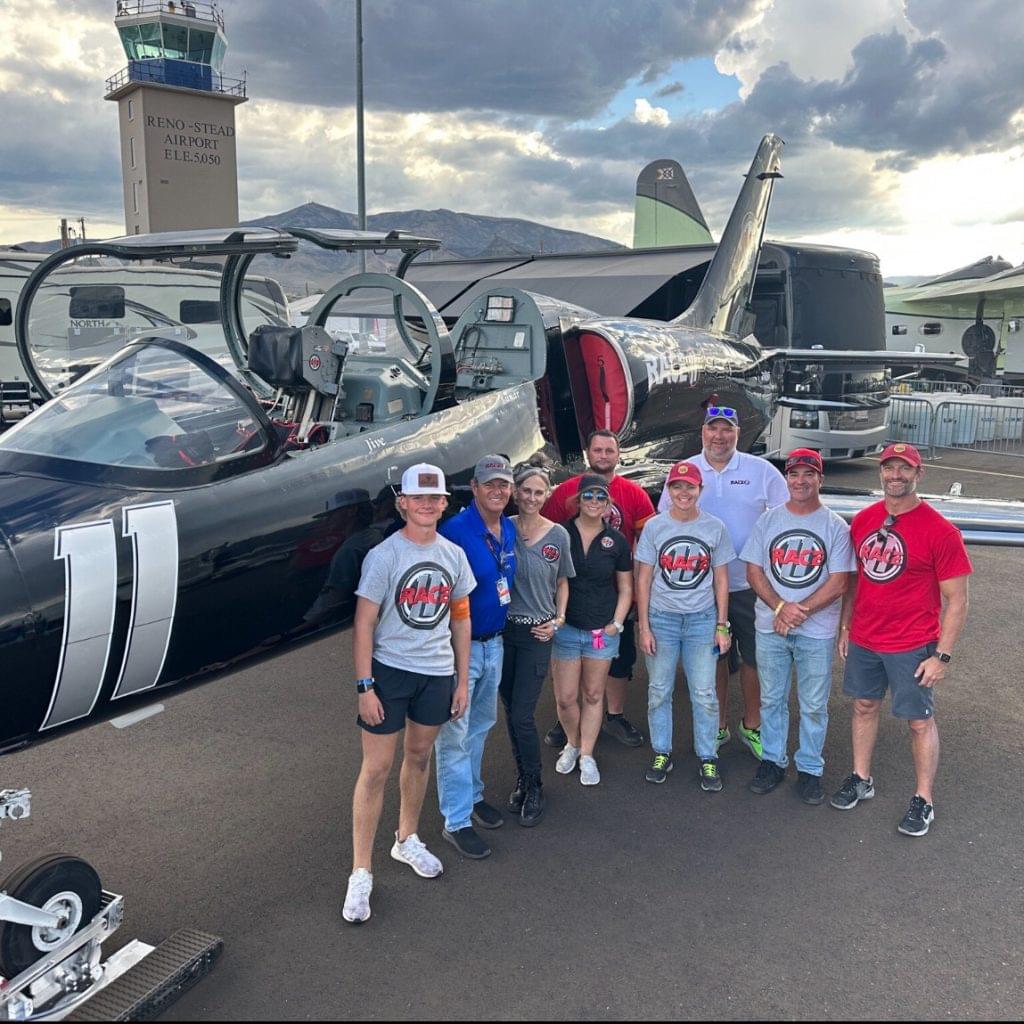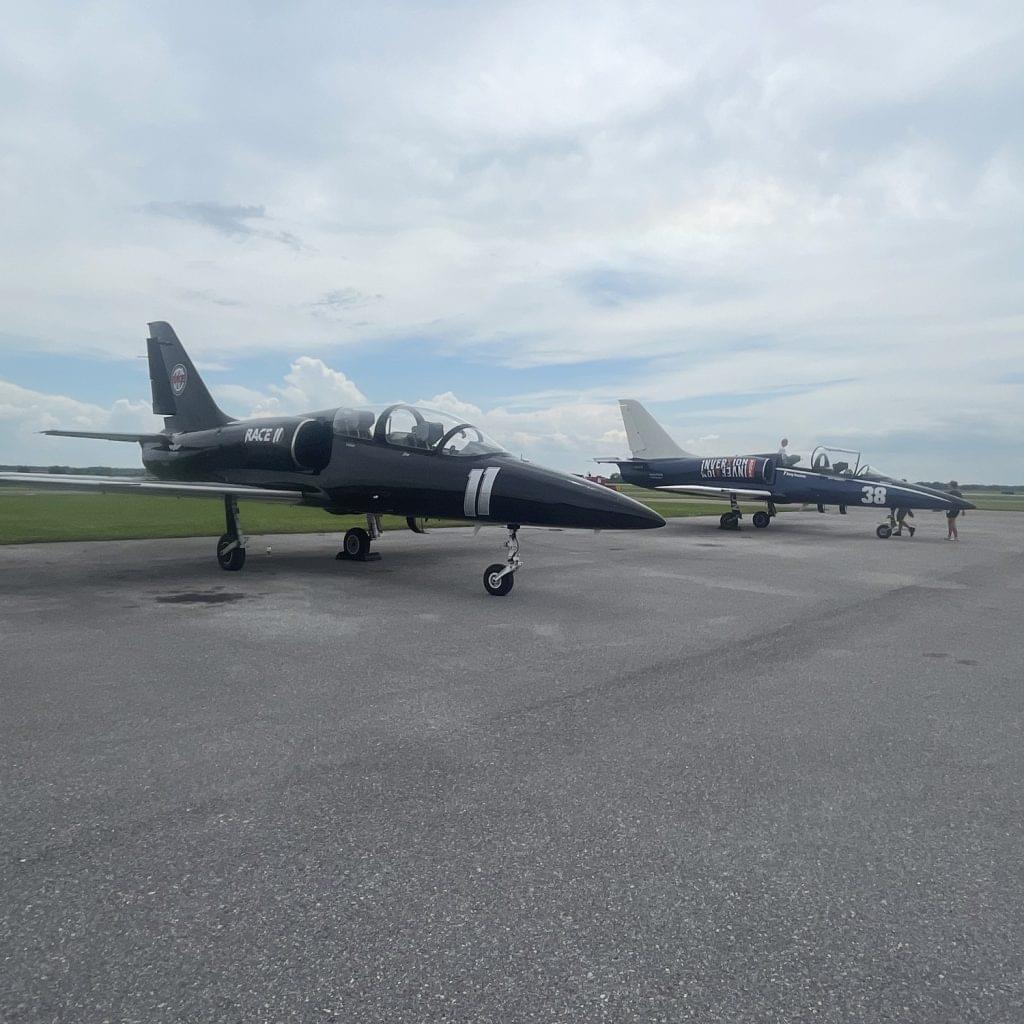If you were in Lake Wales on Saturday morning, many of you may have run out of your homes, or bolted to the window, for a better look at the sky after hearing the surprising roar of an airplane engine. While we have an airport in Lake Wales, and frequently see skydivers, paragliders, and powermotors, the distinct sound of a jet flying at low altitude is pretty unique for our area.
There have been many comments on my original social media post and video with possible explanations for what appeared to many to be a small air show in Lake Wales. Curiosity got me too, and I drove out to the Lake Wales Municipal Airport to try and find the answer. I’m happy to say, I found it.

Lunar and Jive at the September 2023 National Championship Air Races in Reno NV Photo provided
I quickly met LM “Lunar” Sawyer, a resident of Lake Wales, with “Lunar” being her call sign on the air show circuit. She is an air show announcer and manages multiple airshow and air race teams. Her husband, Jerry “Jive” Kerby, is a retired United States Air Force Lieutenant Colonel and fighter pilot. Scott Farnsworth is the lead of Racers Jet Team and an air race pilot. Together, Lunar and Jive own Team Race 11.
I learned that Kerby and Farnsworth were the pilots we saw on Saturday. In an interesting twist, the circumstances under which they fly can sometimes pit them against each other, albeit in the sky.
“They race both together and against each other,” says Sawyer. “As Racers Jet Team, they fly together in formation at air shows (which is what many of us witnessed on Saturday). Today was a rehearsal and a practice because we have an airshow coming up in Las Cruces, New Mexico in October and we needed to get in some practice.”
Setting up a practice, run for a jet of this caliber is no easy task. It requires planning, coordination with the Lake Wales Airport and adjacent jump school and paramotor school (with whom they have great relationships), and pre-authorization and parameters from the FAA, otherwise known as the Federal Aviation Administration.
“What happens is, when we need to practice, Jive and Scott coordinate with the FAA to do what’s called the pop-up airbox, and that means that they can legally practice aerobatics over an airport, or over a location that is designated by the FFA as OK to practice.”
Jive’s plane resides in Lake Wales; he and his wife on an airstrip near Lake Walk-In-Water that’s fully fenced and gated for security purposes. The other plane is based out of the West Palm Beach area.
Because the entire crew, the jets, and the pilots were able to be centralized in Lake Wales this weekend, it was the perfect place for the team to hold their practice session.
“We were able to do a full rehearsal and make sure that they’re ready for the show and feel comfortable; rehearsing is something that they do often,” says Sawyer.

Photo of Team Race 11 Owners LM Lunar Sawyer and Jerry Jive Kerby with the Team Race 11 Crew from the September 2023 National Championship Air Races in Reno NV Photo provided
“The L-39 is a trainer, built in Prague for Eastern Bloc countries, similar to the T-38 in the US. They are two seaters; the trainer sits in the back and the student pilot sits in the front to learn. The L-39 was actually built in the 70s. When the cold war ended, a lot of these came over to the United States, and were sold to private civilians like Scott and Jive. There are several of these on the airshow circuit.”
It’s important to reiterate that safety is paramount; these jets are clearly capable of high speeds and they must legally file their plans with the FAA. Jive is very clear on these rules; he wants the public to understand exactly what we saw on Saturday. he and his team made a conscious choice to have their practice in Lake Wales, at a lower altitude, for some particularly good reasons.
“This was not an advertised event,” says Jive. “This is a practice for us. I am an FAA Certified Aerobatic Competency Evaluator. I have to set up a “box”, or an aerobatic activity area where we can practice. there’s an FAA Notices to Airman, so it warns people flying in the area that this air space is going to be active with high speed aerobatic jet activity.”
That notice was active from 9 AM until 6 PM on Saturday, September 14. During this window, monitors on the ground also watch the air space for any potential issues.

When I asked Jive about how low the team was legally able to fly during this exercise, his response was pretty clear.
“We are authorized down to the surface,” he says. “ That is our legal limit. We were probably between 150 to 200 feet in the air at different points. We have waivers, as part of the aerobatic activity , for speed limits, cloud clearance requirements, and things like that. We ran about 330-350 miles an hour, which are safe airspeeds for us.
“This is a pretty demanding bit of flying that we do, so to be able to have the opportunity to set up these aerobatic areas to legally be able to practice just makes a world of difference in safety, and how prepared we are when we actually get in front of a crowd.”
There have been several comments about the smoke that the jet releases as it is flying. Jive offers this explanation:
“The white ‘smoke’ is generated by inputting, a thin paraffin oil into the hot exhaust of the engine. When the oil is burned, the end result is the white smoke. The smoke is non-toxic and leaves no residue when it dissipates.”
At the time of this interview, Jive was getting ready to do one last flight of the day. when the comment was made about how much he must enjoy flying, he had another simple response.
“Flying? It’s a very special relationship that we have.”
To learn more about Racers Jet Team, click here.


